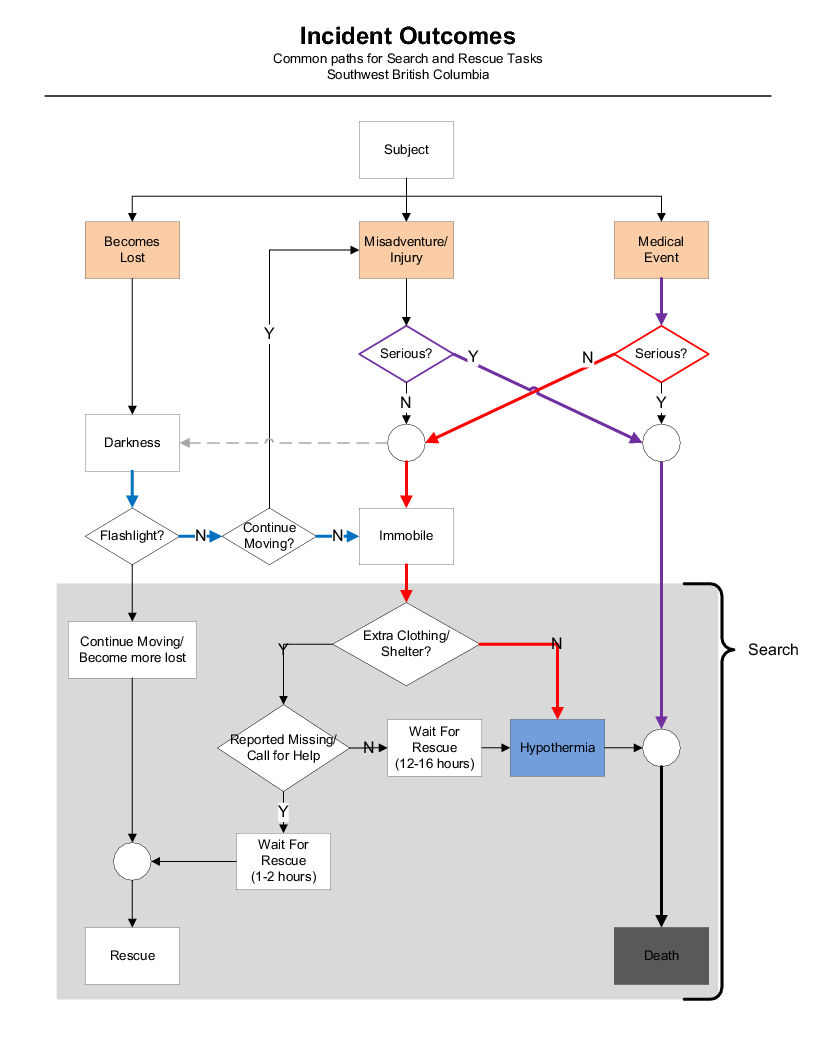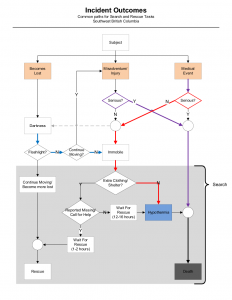Are we rescuing people too soon?

I had a conversation with another SAR member the other day and he mentioned something interesting. He referred to a policy known euphemistically as “the first night’s free” – commonly used in areas that get a lot of SAR calls that are very similar. I’d name the individual SAR teams that have this policy but it’s not important.
The idea is this; if you get lost and call for help, the SAR team will instruct you to hunker down, and wait until the morning when they will send someone to come and get you. That’s it.
Now I know I called this a policy, but it’s a bit more than that – there is a decision making process. You evaluate the individual’s preparedness, you take into account the weather, their health (if they have any medical conditions), and if they are injured; then you make the decision. Some of these factors will change the one night free policy and you’ll launch a rescue, but for most people you just tell them to stay put.
SAR teams that have this policy are typically near a resort of some sort, usually a ski area, that generates a lot of similar calls. Often it’s for people who go missing in the same place, and end up in a certain location.
Here’s the important part. Nobody is dying from having spent that night out.
Vulnerabilities
Of course for every example there’s a counter example. In my personal experience I know of two people my team rescued this year who would definitely not have survived the night. They were poorly dressed, and it was very cold. I also know of several examples of incidents in the area near Metro Vancouver that resulted in the person dying in a single night.
Part of the issue is this – if you don’t have cell phone contact with the subject you are missing a very important piece of the puzzle: their mental state. In many of the examples where people die in the first night, they attempt to continue travelling in the dark. As I wrote when I first started this blog, continuing to travel in the dark puts you on the wrong side of the following flow chart (from 2010). Moving in the dark usually leads to injury, immobility and death – and there are many examples, all of them too grim for me to relate now.

Note that I haven’t updated the flowchart since 2010, but for the “first night free” scenario, we would add 5-6 hours to the Wait for Rescue box. So the consideration for the SAR member becomes the following: Does this lost person have the wherewithal to survive for the next 5-6 hours?
Safety First
The primary, and I mean the very first consideration for every SAR team before sending a single person into the field is safety. Is it safe to send my people out? Is it safe to have them walk around in the dark for 5-6 hours? It is safe to have them rappel down a cliff in the middle of the night? Is it, perhaps, safer to have them do these same things in the daylight?
We weigh that safety against the possibility of harm to the subject, and therein lies the problem. We should not be moving the line on safety for any reason whatsoever – it is irresponsible to risk the well being of the rescuers in this scenario.
In so many instances I’ve seen teams of people hiking in to find a lost hiker who is describing exactly where they are on a trail. Sure, they’re cold. Some of them are a little scared. But they are not in danger. The team takes hours to walk to their location, and then either waits with them until sunrise, or walks them out at night.
Ultimately, if we evaluate that the risk of death from an overnight stay in the bush is little to non-existent, then perhaps the SAR members should stay at home till first light. There’s no point risking even minor injury when it’s just a lost person with no injuries.

Thanks Michael for this timely post.
The Volunteer SAR Teams immediately north of Metro Vancouver (Sea to Sky Corridor) are concerned about the (nearly) daily messaging by one particular “not media shy” Lower Mainland team, that virtually pleads with the public to call them at the first sign of distress. Whatever happened to the common BCSARA mantra that we have preached for years? You know…..the one about being prepared, having requisite skills /tools and exercising personal responsibility in the backcountry (AdventureSmart). How can any rational person expect their call volume to decrease when the (very powerful) message they are communicating dilutes the necessity of being prudent in their planning. Its almost as if “some people” are pushing to make Vancouver’s mountain backyard akin to an English Bay beach scenario, where a lifeguard will come to assist when beckoned, whether it be a life threatening event or a stubbed toe.
The effect this is having in the regional market is that the public is (incorrectly) assuming that all areas of the Province deliver this same “Dial a Rescue” service. And, quite simply put…..not all of us do and some never have.
The reality is that SAR Teams throughout the Province are faced with different sets of circumstances that affect how and when we (RCMP/SAR/AGENCIES) respond to requests for assistance. The one common denominator (if EMBC Policy is followed),is the prudent use of the Urgency Rating Chart. This tool has been around since the sixties and is an invaluable “guideline”. As a tool for decision making, its use is completely subject to it’s handler’s abilities at assessing real life factors and consequences. In the hands of a practiced SAR Management Team it can be skillfully used to determine modified responses and in the hands of the eager, it can be used to justify just about anything. If, we are to believe the barrage of recent media reports, then it would be fairly obvious that the use of this tool is being exercised in a manner that not all of us would agree on.
In your post, you make reference to “the first night’s free” concept. I believe you are referring to the Whistler rescue community’s educational campaign,now some twenty five years old, that had as a tag line “Welcome to the Whistler Backcountry….your first night is free!” This was not intended to be dismissive, uncaring or cute. It was meant to underscore the reality of travelling unprepared in the alpine backcountry during snow season. It may seem harsh to some but is based on the following
1. Call Volume: Whistler receives visitation of approx. four million recreational visits annually. In order to manage this significant potential for emergency services, WSAR has embraced a partnership with Whistler Blackcomb, RCMP,Whistler Heli-skiing, BCAS and the local ACMG members. On any busy day, at supper time, it is not uncommon to have more than a few persons unaccounted for. Based on forty years of observation, WSAR believes that on any given night, there is at least one person wandering around confused and probably very scared but somehow managing to find their way out in day light. Typically the call for help is not even received till the following day.Collectively, over forty years,this is a fairly robust set of data, albeit anecdotal. In this time, from my recollection, no uninjured person has endured a lasting deficit or died from a single night of exposure dressed in ski or snowboard gear.
2. Area: The search area that is accessible in a days ski-hike from the summit of either mountain totals some 65 square kilometres, much of it tracked out. Even with a point last seen, the liklihood of locating someone is minimal (believe me,we have tried). Ground searching at night is at best largely inefficient and if it dips into reserves for the next day’s effort, is it the best use of resources?
3. Terrain: Unlike the terrain responded to by metro Vancouver teams, the Coast Mountains possess significant alpine areas and avalanche terrain, all of which must be assessed and planned prior to ground travel. I think your post covers the issue of weighing safety concerns for rescuers as the utmost consideration very well.
This is not to say that we leave people out in the backcountry. Each report will be investigated and briefings prepared for joint agency discussion. Info from heli ski observations and guided trips will be sought and night shift trail groomers will inventory exit tracks. Avalanche forecasts and terrain analysis will follow. At the end of the process,having vetted and evaluated all the information, a course of action for the night’s efforts will be put forth and sanctioned by the RCMP based on best available information at the time.
The point I am trying to make here, is that humans are more resilient than most people think. Your post very correctly puts emphasis on specific factors that limit this. These of course,need to be put into the decision making matrix.
But…… at the end of the day not everyone has to get HETS’d out of a hiking trail cause its dark and they have no flashlight!
The public’s perception of what constitutes an appropriate rescue response is being largely directed by a select group with media connections. My fear is that this will cause significant problems in the future when all requests for assistance are expected to be treated as urgent ambulance calls.
Brad, thanks for taking the time to reply like this, we all stand to benefit from the perspective you bring.
For those not familiar with the urgency form Brad refers to, it’s ICS form 202 Incident Objectives in the BCERMS ICS form set. The first page of the form contains information about the overall planning for a task and the types of SAR tactics and resources that might be needed. The second page of the form contains the response urgency worksheet. This worksheet contains a number of factors which include Age, Medical Condition, Number of Subjects, Subject Experience, Weather, Equipment, and Terrain. A score is assigned to each category, with a lower score meaning higher urgency.
I think this also speaks to the difficulty some parts of the SAR community have had in terms of embracing a true safety culture. While we generally do a good job of identifying and managing high risk scenarios, we don’t always do the same for moderate risks. Operating at night has certain known benefits for the search phase, but for rescue it contributes nothing but risks. If there’s little or no impact to the subject’s outcome by waiting the night in a known location, assuming the additional risk really doesn’t make sense.
What Brad said, but I think you could expect that from me.
Funky… Just so folks know, the Reply above was Rob’s. He must not have noticed his computer was still logged into WordPress under my account.
What Brad said, but I think you could expect that from me.